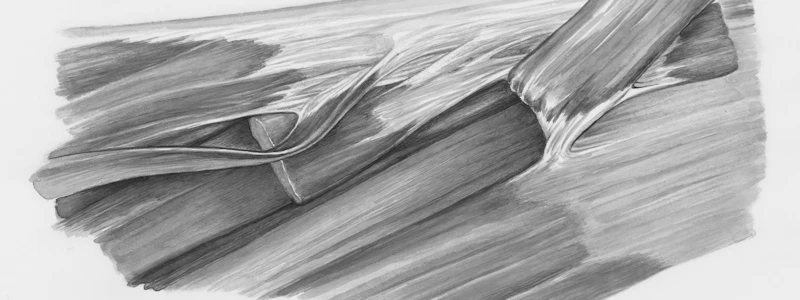Podcast
Questions and Answers
Which muscle is primarily involved in upper cervical flexion?
Which muscle is primarily involved in upper cervical flexion?
- Sternocleidomastoid
- Platysma
- Longus colli
- Longus capitis (correct)
What action do the scalenus muscles contribute to?
What action do the scalenus muscles contribute to?
- Upper cervical flexion only
- Lateral flexion only
- Rotation only
- All of the above (correct)
Which of the following muscles is NOT involved in lower cervical flexion?
Which of the following muscles is NOT involved in lower cervical flexion?
- Scalenus anterior
- Rectus capitis anterior (correct)
- Longus colli
- Sternocleidomastoid
Which muscle is responsible for ipsilateral rotation of the neck?
Which muscle is responsible for ipsilateral rotation of the neck?
Which muscle group primarily stabilizes the hyoid during upper cervical flexion?
Which muscle group primarily stabilizes the hyoid during upper cervical flexion?
In which movement do the Longus colli and scalenus muscles play a significant role?
In which movement do the Longus colli and scalenus muscles play a significant role?
For contralateral rotation of the neck, which muscles are involved?
For contralateral rotation of the neck, which muscles are involved?
Which of the following is a function of the platysma muscle?
Which of the following is a function of the platysma muscle?
Which muscles are primarily responsible for upper cervical extension?
Which muscles are primarily responsible for upper cervical extension?
Which muscles are NOT involved in lower cervical extension?
Which muscles are NOT involved in lower cervical extension?
Which of the following muscles is primarily responsible for contralateral rotation of the neck?
Which of the following muscles is primarily responsible for contralateral rotation of the neck?
During lateral flexion of the neck, which muscle is involved?
During lateral flexion of the neck, which muscle is involved?
What muscle group is primarily responsible for lifting to the right?
What muscle group is primarily responsible for lifting to the right?
Which muscle is NOT associated with lateral flexion of the neck?
Which muscle is NOT associated with lateral flexion of the neck?
Which of the following muscles assists in chopping to the left?
Which of the following muscles assists in chopping to the left?
Which of the following statements is true regarding muscle involvement in movement?
Which of the following statements is true regarding muscle involvement in movement?
Flashcards
Neck Flexion
Neck Flexion
Flexing the neck forward, bringing the chin towards the chest.
Muscles in Neck Flexion
Muscles in Neck Flexion
The main muscles involved in neck flexion are the Longus Capitis, Rectus Capitis Anterior, Suprahyoid, and Infrahyoid muscles.
Lateral Neck Flexion
Lateral Neck Flexion
Flexing the neck to the side, bringing the ear towards the shoulder.
Neck Rotation
Neck Rotation
Signup and view all the flashcards
Neck Extension
Neck Extension
Signup and view all the flashcards
Muscles in Neck Extension
Muscles in Neck Extension
Signup and view all the flashcards
Lateral Neck Extension
Lateral Neck Extension
Signup and view all the flashcards
Muscles in Lateral Neck Extension
Muscles in Lateral Neck Extension
Signup and view all the flashcards
Upper Cervical Extension
Upper Cervical Extension
Signup and view all the flashcards
Lower Cervical Extension
Lower Cervical Extension
Signup and view all the flashcards
Neck Lateral Flexion
Neck Lateral Flexion
Signup and view all the flashcards
Chopping to the Left
Chopping to the Left
Signup and view all the flashcards
Lifting to the Right
Lifting to the Right
Signup and view all the flashcards
Study Notes
Neck Movement Muscles
- Flexion (bending forward): Upper cervical flexion involves longus capitis, rectus capitis anterior, suprahyoid muscles (for tucking the chin) and infrahyoid muscles (to stabilize the hyoid), longus colli, platysma, scalenus anterior, and sternocleidomastoid. Lower cervical flexion also involves these muscles.
- Rotation: Contralateral rotation (turning head to the opposite side) utilizes scalenes (all), sternocleidomastoid and longus capitis and colli, and rectus capitis anterior muscles. Ipsilateral rotation (turning head to the same side) utilizes longus capitis and colli and rectus capitis anterior.
- Lateral Flexion (bending sideways): Longus colli, scalenes (all), and sternocleidomastoid are crucial muscles for lateral flexion.
Neck Extension Muscles
- Extension (bending backward): Upper cervical extension is supported by iliocostalis and longissimus capitis, obliquus capitis (superior and inferior), rectus capitis posterior (major and minor), semispinalis and splenius capitis, and trapezius. Lower cervical extension involves iliocostalis cervicis, longissimus, splenius cervicis, multifidi, rotatores, semispinalis and splenius cervicis, and trapezius.
- Rotation: Contralateral rotation (turning head to opposite side) utilizes multifidi and rotatores, semispinalis capitis, and upper trapezius. Ipsilateral rotation (turning to same side) utilizes obliquus capitis inferior, splenius cervicis and capitis.
- Lateral Flexion: Iliocostalis cervicis, intertransversarii (cervical), longissimus capitis, obliquus capitis superior, splenius cervicis and capitis, and trapezius are employed in lateral flexion.
Other Movements and Muscles
- Chopping to the left: Left external oblique, rectus abdominis, and right internal oblique are involved.
- Lifting to the right: All neck and back extensor muscles, and left multifidi and rotatores, are crucial.
- Bilateral lower extremity flexion to the left: Left internal oblique, rectus abdominis, and right external oblique participate.
- Bilateral lower extremity extension to the right: All back and neck extensor muscles, right quadratus lumborum, and left multifidi and rotatores play important roles.
Studying That Suits You
Use AI to generate personalized quizzes and flashcards to suit your learning preferences.



